
| Palaeos |  |
Ornithischia |
| Vertebrates | Stegosauria |
| Page Back | Unit Home | Unit Dendrogram | Unit References | Taxon Index | Page Next |
| Unit Back | Vertebrates Home | Vertebrate Dendrograms | Vertebrate References | Glossary | Unit Next |
|
Abbreviated Dendrogram
DINOSAUROMORPHA |--+--THEROPODA | `--SAUROPODOMORPHA | ORNITHISCHIA |--Thyreophora | |--Scutellosaurus | `--Eurypoda | |--Stegosauria | | |--Huayangosauridae | | | |--Emausaurus | | | `--Huayangosaurus | | `--Stegosauridae | `--Ankylosauria `--Cerapoda |--Ornithopoda | |==Hypsilophodontidae | `--Hadrosauridae `--Marginocephalia |--Pachycephalosauria `--Ceratopsia |
Contents
Overview |
Plated dinosaurs - mostly Jurassic, spines along the back and tail for protection, plates served a thermoregulatory purpose. Quadrupedal, short forelimbs, slow-moving. Length 4 to 10 meters
The Stegosaurs are a distinctive component of the Jurassic megafauna. These striking dinosaurs are characterized by pairs of bony plates along the back (presumably for the purpose of thermoregulation) and varying numbers of pairs of spikes along the tail and, in some species the back, hips, and even shoulders. Despite their protective spikes, they were never a very diverse group. Reasonably common during the Middle and Late Jurassic, the stegosaurs were almost wiped out by the Tithonian extinction event. Stragglers continued on to the Early or middle Cretaceous, and perhaps even later on the island continent (as it was then) of India.
The stegosaurs are divided into a number of families, typically with only one well-known member each. These may or may not be monophyletic. Stegosaurs are not very diverse, and there is a reasonably good chance that we are looking at ancestor - descendant relationships, rather than separate clades.
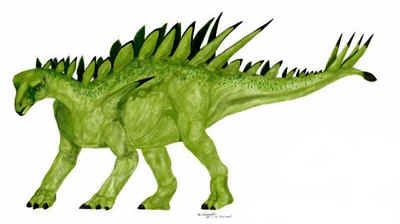 |
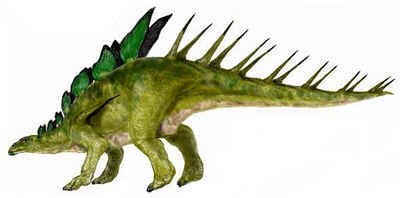 |
| UPPER: Huayangosaurus tabii Dong et al.. 1982 from the Middle Jurassic of China. About 4m. LOWER: Kentrosaurus aethiopicus Hennig 1915, from the Late Jurassic of Tanzania. About 5m and 450 kg. Both images © M. Shiraishi, reproduced with permission. |
The Huayangosaurs were earliest well-known forms, and lived during the Early to Middle Jurassic. They are generally much smaller than the later stegosaurids. The skull is short and high relative to later stegosaurs, and retains the archosaurian antorbital fenestra (opening in front of the eyes). Although Huayangosaurus is the only certain form, it is likely that other earlier types like Tatisaurus and Emausaurus also belong here. An early Cretaceous jaw of uncertain affinities called Regnosaurus northamptoni has been placed in this group, on the basis of its strong resemblance to the lower jaw of Huayangosaurus, but in view of the incomplete nature of the specimen and its much later date (contemporary with the latest advanced stegosaurines) one may remain skeptical.
The Dacentrurinae were late persisting primitive types, that seem to have characteristics indicating a type ancestral to other stegosaurids (even if they themselves are too late in time to be an actual ancestor). The vertebrae are more primitive and the forelimbs longer in comparison to the hind-limbs. Although Dacentrurus armatus is the only certain species, an early femur has been referred to that species.The Kentrosaurinae are primitive stegosaurids, small to large in size, with generally small spiky plates and numerous spikes along the tail, and sometimes the hips and shoulders as well. A paraphyletic group, they are transitional between the Dacentrurines and the stegosaurines.
The Stegosaurinae are the most specialized stegosaurids, with generally larger plates and spikes that tend to be limited to the end of the tail, although primitive forms still retain additional spines. One could distinguish two tribes: the Tuojiangosaurini, which may be ancestral, and the Stegosaurini. The tuojiangosaurines generally retain the Kentrosaurine pattern of back and hip spines. The stegosaurines are distinguished by large size, no spines on hips or shoulders, only two (or rarely 4) pairs of tail spines, relatively short forelimbs, a small elongate head, and large plates in life covered with skin and blood vessels. This tribe includes only two genera, Stegosaurus and Wuerhosaurus. The controversial dinosaurologist Bob Bakker distinguishes between two types of Stegosaurus - those with long legs and relatively smaller plates (Stegosaurus proper) and a more primitive form with shorter legs and larger plates (Diracodon). Others are critical of proposing a new stegosaur genus on this basis. Also, different sources (both in print and on the Web) give different lists of species; e.g. some are synonymized with others. It may be that some of these species are only subspecies or local variants. MAK990724
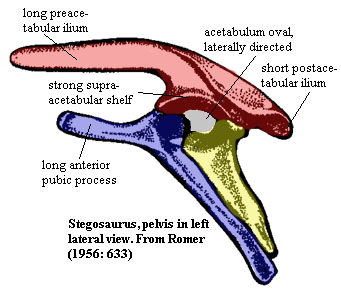 Stegosauria:
Stegosaurus > Ankylosaurus.
Stegosauria:
Stegosaurus > Ankylosaurus.
Range: mJ-upK, fl upJ.
Phylogeny: Eurypoda : Ankylosauromorpha + * : Huayangosauridae + Stegosauridae.
Characters: Medium to large (to 9m) [G90]; skull:
skull relatively small, low and wedge-shaped with long facial region [R56];
premaxilla & mandible covered with rhamphothecae[G97]; premaxilla dorsal
process does not reach lacrimal [G90]; nares elongate ovals [R56]; nasals &
maxillae elongate [R56]; nasals longest bone in skull [G90]; fleshy cheeks
likely present with supporting ridges on maxilla & dentary for musculature
[G90] [G97]; flat parietal plate separates small upper temporal fenestrae [R56];
orbit large for small skull, with 3 supraorbital (modified palpebrals) on dorsal
rim [R56]; palpebrals exclude prefrontal & frontal from orbit [G90];
postorbital triradiate [G90]; jugal overlaps quadratojugal which overlaps
quadrate [G90]; lateral temporal fenestra large [R56]; squamosal triangular
& roofs posterolateral section of lateral temporal fenestra [G90]; quadrate
probably immovable, with simple orthal chomping [G97]; quadrate nearly vertical
ventrally [R56]; $ quadrate pterygoid ramus with large oval
fossa [SD92]; jaw articulation well below toothrow [R56]; $
quadrate articular ramus ("head") large, rectangular & plate-like
[SD92]; occipital condyle large & mostly from basioccipital [G90]; deep
median keel on hard palate (may have supported soft secondary palate) from
vomers, palatines & pterygoids [G90] [G97]; rounded, ventrally directed
pterygoid flanges [G90] [R56]; pterygoid quadrate ramus slants sharply back (?)
[R56]; pterygoid quadrate ramus forms large fossa or fenestra [G90]; pterygoid
vacuities very small [G90]; pterygoid body overlaps basisphenoid [G90];
remarkably small brain; predentary present (single?) [G90] [G97]; predentary
does not extend to as far as premaxilla [G90]; jaw, particularly dentary,
elongate [R56]; coronoid eminence formed into long vertical ridge [G90];
coronoid emminence largely from surangular [G90]; ridge rises and hides
posterior teeth in lateral view [G90]; articular broad & thick [G90]; teeth
smaller than mot ornithischians [G90]; cheek teeth with simple crowns, bulbous
cingulum & few wear facets; teeth with enamel on both surfaces [R56];
significant species differences in form & arrangement of teeth, although all
generally foliate [G90]; axial: $ no
ossified tendons [G90] [SD92] [G97]; centra amphiplatyan anteriorly &
strongly amphicoelous posteriorly [G90] [R56]; atlas arches fused to
intercentrum [G90]; odontoid process present and ankylosed to axis centrum
[G90]; short cervical ribs [R56]; anterior dorsal vertebrae with neural canal
>50% diameter of centrum [SD92]; $ dorsal vertebrae tall due
to long neural arch pedicels > 150% centrum height [SD92]; upward-slanting
articulations with ribs (increased size of body cavity) [G97]; neural canal
enlarged in  posterior
cervicals (brachial plexus) and posterior dorsals (but cut here by septum)
[G97]; diapophyses angled upward 50-60° in mid-dorsals ($ per
[SD92]), decreasing to 25-40° anteriorly & posteriorly [G97]; length of
transverse processes increases posteriorly [G90]; plates supported by angled
diapophyses and by ribs; mid-dorsal ribs with T-shaped crossection, flat
dorsally [G97]; zygapophyses meet anteromedially to form V-shaped anterior slot
[G90]; centra massive [G90]; sexual dimorphism(?) with additional 1st
sacral rib (of 4-6) in some species; sacral enlargement of neural canal for
sacral plexus, motor nerves for caudofemoralis and other leg muscles, and
possibly glycogen body as in birds (unknown function) [G97]; caudo-sacral
transition marked by assymetric vertebrae permitting lateral, but not vertical
movement of tail [G97]; caudal vertebrae vary considerably with species [G90];
caudal neural canals small [G90]; anterior caudal centra laterally expanded
expanded & posterior caudal centra almost square [G97]; $
posterior caudal centra almost square [SD92 & G97]; appendicular:
$ parascapular spine with expanded base projecting
posterolaterally from shoulder [G90] [SD92]; scapular blade becomes wider
distally [G90]; $ lower scapula (acromion process) broad &
plate-like (except Huayangosaurus?) [G90] [SD92] [G97]; clavicles,
interclavicles & (probably) sternum absent [G90]; forelimbs short &
massive [G90]; humerus short, massive, with expanded ends [G97]; humerus with
large deltopectoral crest & lateral epicondyle [G90]; $ humerus
with prominent triceps tubercle (see figure)
and descending ridge [SD92]; manus elephantine & inflexible [G97]; $
(1? or) 2 blocklike compound carpals in adults [G90] [SD92]; $
intermedium & ulnare fused & no distal carpals [SD92][G97]; 5 short
metacarpals with short digits, at least two with hoof-like unguals [G90] [G97];
long anterior process of ilium & short posterior process [R56]; short
ischium with prominent emminence on dorsal midshaft [G90]; ischia in contact
only distally [G90]; $ long anterior pubic process (>50%
length of posterior pubic process) [SD92] [G97]; pubic anterior process distally
expanded [G90]; $ acetabulum oval & laterally directed
[SD92] [G97]; strong supraacetabular shelf [R56]; femur columnar, (very) long,
flattened anteroposteriorly & wide [G90] [G97]; femur lacks proximal
constriction ("neck") [G90]; femur lesser trochanter small or absent
[G90]; femur 4th trochanter as low ridge [G90]; tibia short, massive & may
be fused with fibula distally [G90]; astragalus massive & articulates
proximally only with tibia [G90]; calcaneum small and variable [G90];
metatarsals short, straight & divergent [G90]; pes with I absent & V
reduced, II & IV symmetrical [G97]; pedal phalanges much larger than manual
[G90]; pes II-IV with hoof-like unguals [G90] [G97]; integument:
2 parasagittal rows of anterior plates & posterior spikes; $
"prominent osteoderms that angle slightly away from the sagittal plane and
grade in form from ... plates to ... spikes ... ." [SD92]; plates are
paired in all except Stegosaurus [G97]; plates supported richly
vascularized tissue (thermoregulatory?); quadrupedal [G90], graviportal;
low-level browsers.
posterior
cervicals (brachial plexus) and posterior dorsals (but cut here by septum)
[G97]; diapophyses angled upward 50-60° in mid-dorsals ($ per
[SD92]), decreasing to 25-40° anteriorly & posteriorly [G97]; length of
transverse processes increases posteriorly [G90]; plates supported by angled
diapophyses and by ribs; mid-dorsal ribs with T-shaped crossection, flat
dorsally [G97]; zygapophyses meet anteromedially to form V-shaped anterior slot
[G90]; centra massive [G90]; sexual dimorphism(?) with additional 1st
sacral rib (of 4-6) in some species; sacral enlargement of neural canal for
sacral plexus, motor nerves for caudofemoralis and other leg muscles, and
possibly glycogen body as in birds (unknown function) [G97]; caudo-sacral
transition marked by assymetric vertebrae permitting lateral, but not vertical
movement of tail [G97]; caudal vertebrae vary considerably with species [G90];
caudal neural canals small [G90]; anterior caudal centra laterally expanded
expanded & posterior caudal centra almost square [G97]; $
posterior caudal centra almost square [SD92 & G97]; appendicular:
$ parascapular spine with expanded base projecting
posterolaterally from shoulder [G90] [SD92]; scapular blade becomes wider
distally [G90]; $ lower scapula (acromion process) broad &
plate-like (except Huayangosaurus?) [G90] [SD92] [G97]; clavicles,
interclavicles & (probably) sternum absent [G90]; forelimbs short &
massive [G90]; humerus short, massive, with expanded ends [G97]; humerus with
large deltopectoral crest & lateral epicondyle [G90]; $ humerus
with prominent triceps tubercle (see figure)
and descending ridge [SD92]; manus elephantine & inflexible [G97]; $
(1? or) 2 blocklike compound carpals in adults [G90] [SD92]; $
intermedium & ulnare fused & no distal carpals [SD92][G97]; 5 short
metacarpals with short digits, at least two with hoof-like unguals [G90] [G97];
long anterior process of ilium & short posterior process [R56]; short
ischium with prominent emminence on dorsal midshaft [G90]; ischia in contact
only distally [G90]; $ long anterior pubic process (>50%
length of posterior pubic process) [SD92] [G97]; pubic anterior process distally
expanded [G90]; $ acetabulum oval & laterally directed
[SD92] [G97]; strong supraacetabular shelf [R56]; femur columnar, (very) long,
flattened anteroposteriorly & wide [G90] [G97]; femur lacks proximal
constriction ("neck") [G90]; femur lesser trochanter small or absent
[G90]; femur 4th trochanter as low ridge [G90]; tibia short, massive & may
be fused with fibula distally [G90]; astragalus massive & articulates
proximally only with tibia [G90]; calcaneum small and variable [G90];
metatarsals short, straight & divergent [G90]; pes with I absent & V
reduced, II & IV symmetrical [G97]; pedal phalanges much larger than manual
[G90]; pes II-IV with hoof-like unguals [G90] [G97]; integument:
2 parasagittal rows of anterior plates & posterior spikes; $
"prominent osteoderms that angle slightly away from the sagittal plane and
grade in form from ... plates to ... spikes ... ." [SD92]; plates are
paired in all except Stegosaurus [G97]; plates supported richly
vascularized tissue (thermoregulatory?); quadrupedal [G90], graviportal;
low-level browsers.
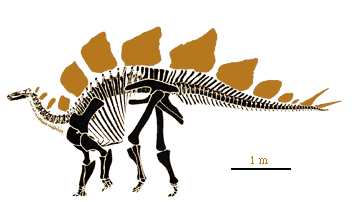
References: Galton (1990) [G90]; Galton (1997) [G97]; Romer (1956) [R56]; Sereno & Dong (1992) [SD92].
Note: [1] Romer's concept of the Stegosauria is a little different from current ideas. He did not have Huayangosaurus, and considered Scelidosaurus to be a stegosaurian. Therefore, his description (1956: 632-33) has been selectively incorporated and should be taken with some caution. [2] The fusion of the odontode process and axis centrum is strange. Something similar occurs in ceratopsians and is believed to be an adaptation for holding up the massive head. That makes good sense -- but why here? ATW040729
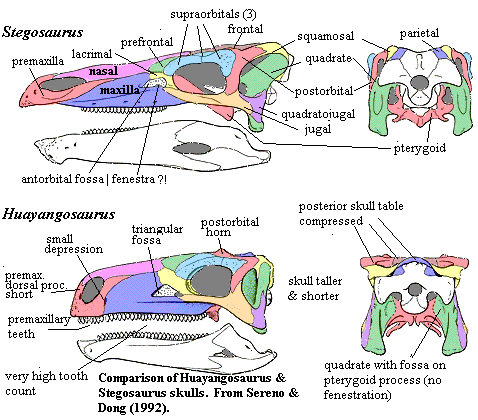 Huayangosauridae:
Regnosaurus (probably), Tatisaurus?
Huayangosauridae:
Regnosaurus (probably), Tatisaurus?
Range: Early Jurassic to Early Cretaceous of Europe and China
Phylogeny: Stegosauria : Stegosauridae + * : Emausaurus + Huayangosaurus.
Comments: It is still controversial whether or not Tatisaurus is a proper stegosaurian, but it is the earliest known (but not the most primitive) member of the dinosaurian clade Thyreophora, a group that included various types of armoured dinosaurs. It is still not very far removed from its "fabrosaur" ancestors, but within a few million years Tatisaurus, or a form like it, evolved into large armoured quadrepeds. This poorly-known ornithischian has been related to Scelidosaurus, but seems to be more closely related to the Stegosauria. Possibly it represents a form transitional between or ancestral to the two groups.
Characters: smaller than stegosaurids; skull: skull shorter, broader and taller than stegosaurids [SD92] [G97]; premaxillary attachment for beak present [SD92]; dorsal process of premaxilla short & broad [G90]; nares small [G90]; $ small oval depression between maxilla & premaxilla on lateral snout [SD92]; retain antorbital fenestra [SD92]; antorbital fenestra set in deep, triangular antorbital fossa [SD92]; antorbital fossa rimmed by maxilla & lacrimal, with small contribution from jugal [SD92]; orbits located relatively far forward above posterior cheek teeth; prefrontal overlaps frontal and nasal [SD92]; $ (possibly sexually dimorphic) little "horns" on postorbital [SD92]; posterior and median processes of postorbital overlap squamosal & jugal (respectively) [SD92]; parietal short (~50% frontal length) [SD92]; vomers short [G90]; braincase poorly known [G90]; stapes slender [G90]; external mandibular fenestra smaller than in stegosaurids [G90]; premaxilla with 7 teeth [G97]; $ maxilla (and dentary [G90]) with 25-30 teeth [SD92]; no diastema on lower jaw [G97]; axial: vertebral count 8, 17-18, 4, 35-42 [G90]; $ anterior dorsal ribs with intercostal flanges ("hamular processes" [G90]) and flared distal ends [SD92]; flared distal rib ends; postzygapohyses separated by notch [G90]; sacrum with 3 large foramina between transverse processes [G90]; appendicular: scapula without well-defined acromion process [G90]; coracoid wider than long & only slightly wider than scapular blade [G90]; forelimbs relatively long, with humerus 90% of femur length [SD92]; $ intermedium, ulnare, pisiform and radiale fused to carpal block [SD92]; ilium anterior process broad, angles laterally ~35° [G90]; antitrochanter small [G90]; ischial peduncle pronounced [G90]; integument: spiked-shaped armor along the body midline; keeled armor scutes in a row down its sides [SD92].
Links: DinoData: Huayangosauridae; Dinosauria Translation and Pronunciation Guide H; Huayangosaurus; Stegosaurs, Ankylosaurs (October 8); New Page 5; Huayangosaurus; Um Corpo Cheio de Espetos (Portuguese); Stegosaurs; Huayangosauridae (German, very brief); DinoWight- Regnosaurus, an Isle of Wight stegosaur (one of the few pages with information on Regnosaurus).
References: Galton (1990) [G90]; Galton (1997) [G97]; Sereno & Dong (1992) [SD92] (characters from this ref refer to Huayangosaurus only).
Note: this group tends to be discussed in terms of its shared primitive characters -- a dangerous sign. ATW020208.
Range: Middle Jurassic (Bathonian - Calovian) of China
Phylogeny: Huayangosauridae : Emausaurus + *.
Huayangosaurus taibii Dong, Tang, and Zhou,
1982
Age: Bathonian-Callovian
Place: north-east Pangea
Remains: complete skeleton, skull, fragmentary postcrania
Length: 4.3 meters
Weight: 400 kg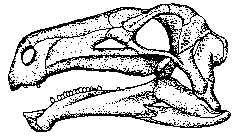
Comments: Huayangosaurus is one of the best-known stegosaurians, with remains belonging to over a half dozen individuals. The skull (left) is deep with a relatively short snout, and has what may be little "horns," which may be a gender-related character. It is also unique for having armor scutes, something like those of scelidosaurs and ankylosaurs, in a row down its sides. This is one of the characters which indicate that these three groups are descended from a common ancestor and may be combined in a single clade, the Thyreophora. Huayangosaurus is protected by two pairs of tail spikes and a pair of spines on the shoulders
Links: DinoData Dinosaurs H046 HUAYANGOSAURUS; Chinese Dinosaurs - Huayangosaurus taibaii; HUAYANGOSAURUS; Movie 5-Huayangosaurus; Huayangosaurus; Yahooligans! Science- Dinosaurs; UM CORPO CHEIO DE ESPETOS; New Page 5; STEGOSAURS, ANKYLOSAURS (October 8); Lecture 7 - Ornithischia - Stegosauria; Otago Museum hosts Dinosaur Exhibition.
| Page Back | Unit Home | Page Top | Page Next |
checked ATW060215